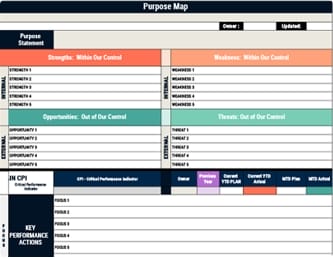When you’re tasked with creating performance dashboards that truly drive action, start by focusing on the essentials of visual management boards. It’s crucial to centralize key performance indicators (KPIs) so your team can easily spot improvement areas. Customizing dashboards to reflect your team’s unique challenges is vital for fostering engagement. By incorporating real-time data visualization and color-coded indicators, you create clarity. But how do you ensure these tools are effectively implemented and embraced?
Key Takeaways
- Customize dashboards to reflect team-specific priorities and challenges, promoting relevance and engagement.
- Use real-time data visualization to enable timely decision-making and drive actionable insights.
- Incorporate clear visual representations, like bar charts and line graphs, for instant clarity on performance metrics.
- Facilitate team ownership by involving members in the dashboard customization process.
- Regularly assess and update dashboards to ensure continuous improvement and relevance.
Understanding the Essentials of Visual Management Boards
Visual Management Boards are powerful tools designed to streamline communication and improve team performance by visually conveying critical information through three fundamental elements: standards, problems, and actions.
By setting clear standards, you establish target performance metrics, making it easier to identify problems when deviations occur. Using color-coded indicators, you can quickly spot issues; green signifies normalcy, while red highlights problems, facilitating rapid problem resolution.
Engaging team members through effective communication is essential, and these boards promote ownership by allowing handwritten elements, contrasting with passive computer data consumption.
Customization of the boards should reflect your team’s specific priorities and challenges, ensuring each member is actively involved. This approach enhances understanding and drives the necessary actions to maintain and improve performance.
Key Elements for Effective Performance Dashboards
A well-designed performance dashboard is essential for effectively tracking and optimizing team performance, providing a centralized platform where key performance indicators (KPIs) are prominently displayed to ensure alignment with organizational goals.
Effective visual management hinges on real-time data visualization, which allows you to make timely decisions and respond quickly to deviations. Dashboards provide clear visual representation through bar charts and line graphs, simplifying complex data for everyone.
Customizing dashboards ensures each team member accesses relevant data tailored to their roles, driving continuous improvement efforts. By regularly assessing and gathering feedback, you can enhance the dashboard’s effectiveness, providing actionable insights that help track progress and drive continuous improvement.
This approach ensures your team remains aligned and accountable.
Customizing Dashboards for Team Engagement
To effectively engage your team through dashboards, it’s crucial to customize them to reflect the unique priorities and challenges specific to your team, which fosters a stronger sense of ownership and connection to performance metrics.
Start by incorporating team-specific elements that highlight your goals, using handwritten updates in green or red pens for instant clarity on performance status.
Design dashboards for functionality over aesthetics, ensuring accessibility and easy updates by all team members.
Make dashboards dynamic conversation starters, facilitating structured discussions that delve into performance insights.
Regularly involve your team in the customization process, which not only encourages ownership but also ensures the boards reflect relevant updates and ongoing changes.
This approach transforms dashboards into powerful tools for team engagement and problem-solving.
Types of Visual Management Boards to Consider
Customizing dashboards for team engagement lays a strong foundation for exploring the various types of visual management boards that can further enhance your team’s efficiency and performance tracking.
Start with Kanban Boards, which use color-coded cards for effective workflow management in lean manufacturing, helping you keep track of task statuses and inventory.
Next, consider Daily Management Boards to monitor performance metrics in real-time, enabling collaborative goal setting and reviews.
For continuous improvement, Kaizen Boards encourage identifying and implementing process enhancements.
Implement 5S Boards to streamline operations using the principles of Sort, Set in order, Shine, Standardize, and Sustain.
Lastly, SQCDP Boards focus on Safety, Quality, Cost, Delivery, and People, providing a comprehensive view of critical performance metrics.
Implementing Visual Management Tools Successfully
Implementing visual management tools successfully hinges on team ownership, as it’s crucial that these boards reflect your team’s unique priorities to foster engagement and avoid becoming mere static displays.
Customization is vital; standard visual displays can hinder ownership, so tailor them to include specific performance metrics like safety and quality.
Position these tools within accessible areas to encourage regular use and facilitate structured discussions.
Employee engagement is enhanced through hands-on training, ensuring everyone understands how to leverage these tools effectively.
Regularly assess and update the boards for continuous improvement, adapting to changing needs.
Encourage feedback to maintain relevance and drive accountability.
Leveraging Technology for Enhanced Visual Management
Harnessing technology in visual management can significantly amplify the effectiveness and engagement of your team’s efforts. By leveraging visual management systems like Tervene, you can create customizable dashboards that provide real-time data integration and visibility into performance data across operations.
Digital Kanban boards facilitate instant updates and improve task management, enhancing collaboration among team members, even if they’re scattered across multiple locations. Mobile applications ensure that front-line workers receive timely alerts and updates directly on the shop floor, promoting agile decision-making.
Utilize advanced visualization technologies, such as interactive charts, to simplify complex data, helping your team identify trends and bottlenecks effectively. By integrating these tools, you enhance your ability to respond swiftly to deviations from targets, ensuring operational efficiency.
Frequently Asked Questions
How to Create a Management Dashboard?
To create a management dashboard, start by identifying and prioritizing key performance indicators (KPIs) that align with your organization’s goals, ensuring the dashboard reflects essential metrics.
Choose effective data visualization techniques like bar charts and line graphs to make data insights clear. Organize data logically for a user-friendly interface, enabling intuitive navigation.
Integrate real-time data with automated updates, and customize the dashboard for different roles to enhance targeted monitoring and decision-making.
What Is the 1 3 10 Rule in Lean?
Ever heard of the 1 3 10 Rule in Lean? It’s a game-changer for quick decision-making.
In just a second, you’ll spot if everything’s on track with a simple glance at color codes—green is good, red signals trouble.
Then, in three seconds, you can pinpoint the problem.
Finally, within ten seconds, the board reveals the necessary actions and who’s responsible, streamlining communication and enhancing team performance.
What Are the Three Types of Visual Management?
You’re asking about the three types of visual management boards, which are SQCDP, Kanban, and Kaizen Boards.
SQCDP Boards help you track Safety, Quality, Cost, Delivery, and People metrics, providing immediate insights into performance.
Kanban Boards use color-coded cards to manage tasks and inventory, optimizing workflow.
Kaizen Boards focus on continuous improvement, encouraging team involvement by highlighting process enhancements.
Each board type boosts efficiency and accountability through clear, accessible information.
How Visual Management Helps in Sustaining Actions Taken During First 3S?
Think of visual management as the orchestra conductor ensuring harmony in sustaining your 3S actions.
You’ll use color-coded indicators to quickly pinpoint areas needing maintenance, preventing the loss of initial 3S benefits. By regularly updating performance metrics, you promote accountability and motivate your team to uphold standards.
Daily discussions facilitated by these boards allow you to collaboratively tackle challenges, while handwritten notes add immediacy, encouraging ownership of ongoing improvements.
Conclusion
To harness the full potential of visual management boards, think of them as your team’s North Star, guiding you toward continuous improvement. Prioritize customizing dashboards to meet your unique challenges, ensuring real-time data visualization is clear and actionable. Use color-coded indicators for quick, intuitive assessments, and embrace technology to enhance these tools. Regularly assess and refine your approach, fostering a culture of informed decision-making and engagement, much like an artist refining their masterpiece with each brushstroke.



